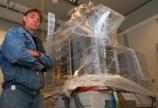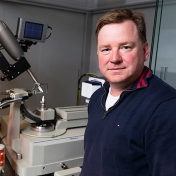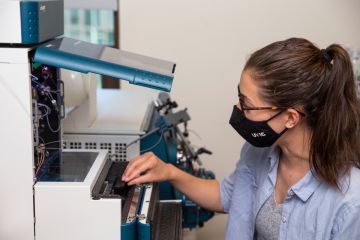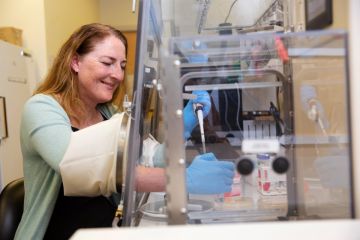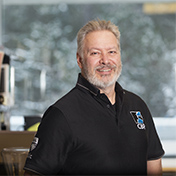World’s most advanced microscope is here
- Valerie Shore
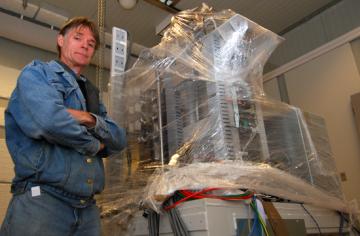
The University of Victoria is now home to the most powerful microscope ever built. On May 22, the 7-tonne, 4.5-metre tall Scanning Transmission Electron Holography Microscope (STEHM) arrived on campus in 22 pieces. The next day, four large pieces were lowered into a special room in the basement of the Bob Wright Centre, where the microscope is now being assembled.
The four pieces were so large that a hole had been cut in advance in the entranceway to the Bob Wright Centre so that they could be lowered into the basement, where UVic’s Advanced Microscopy Facility is located.
The STEHM is a one-of-a-kind machine built for UVic in Japan by Hitachi High Technologies Canada and is the highest-resolution microscope in the world. It will allow researchers to see things 20 million times smaller than the tiniest thing the unaided human eye can see.
Unlike conventional microscopes, which use light to peer at specimens, the STEHM uses an electron beam and holography techniques to observe the inside of materials and their surfaces to an expected resolution smaller than the size of an atom.
The STEHM will see materials beyond the nanoscale to the picoscale. A nanometer is one-billionth of a metre, while a picometre is one-trillionth of a metre. Atoms are typically between 62 and 520 picometres in diameter.
In the world of advanced microscopy, the quality of images depends on the electron source and its lenses. The electron source for the STEHM is about 30 times brighter than existing conventional electron sources. And while standard high-resolution microscopes have about 20 lenses for imaging the specimen, the STEHM has 50.
The microscope is so sensitive that its image could be affected by little more than a passing cloud. For this reason, it is housed in a special self-contained, extra-tall room that is anchored to bedrock and encased in eight inches of insulation sandwiched between layers of galvanized steel.
“This machine will be used for thousands of different types of research by scientists from around the world, who are already lining up to use it,” says Rodney Herring, a professor of mechanical engineering and director of UVic’s Advanced Microscopy Facility.
Engineers, physicists, chemists, biologists and medical researchers will use the STEHM to better understand subatomic structures relevant to areas such as medical and environmental diagnostics, communications, computers, alternative energy and manufacturing.
“This microscope will open up a hidden world and gives UVic a research capability that no other institution has,” says Herring.
The STEHM microscope facility is supported by $9.2 million in funding from the Canada Foundation for Innovation, the BC Knowledge Development Fund and UVic, as well as significant in-kind support from Hitachi.
STEHM video: http://youtu.be/WJUL22UoCLI
Photos
In this story
Keywords: microscope

